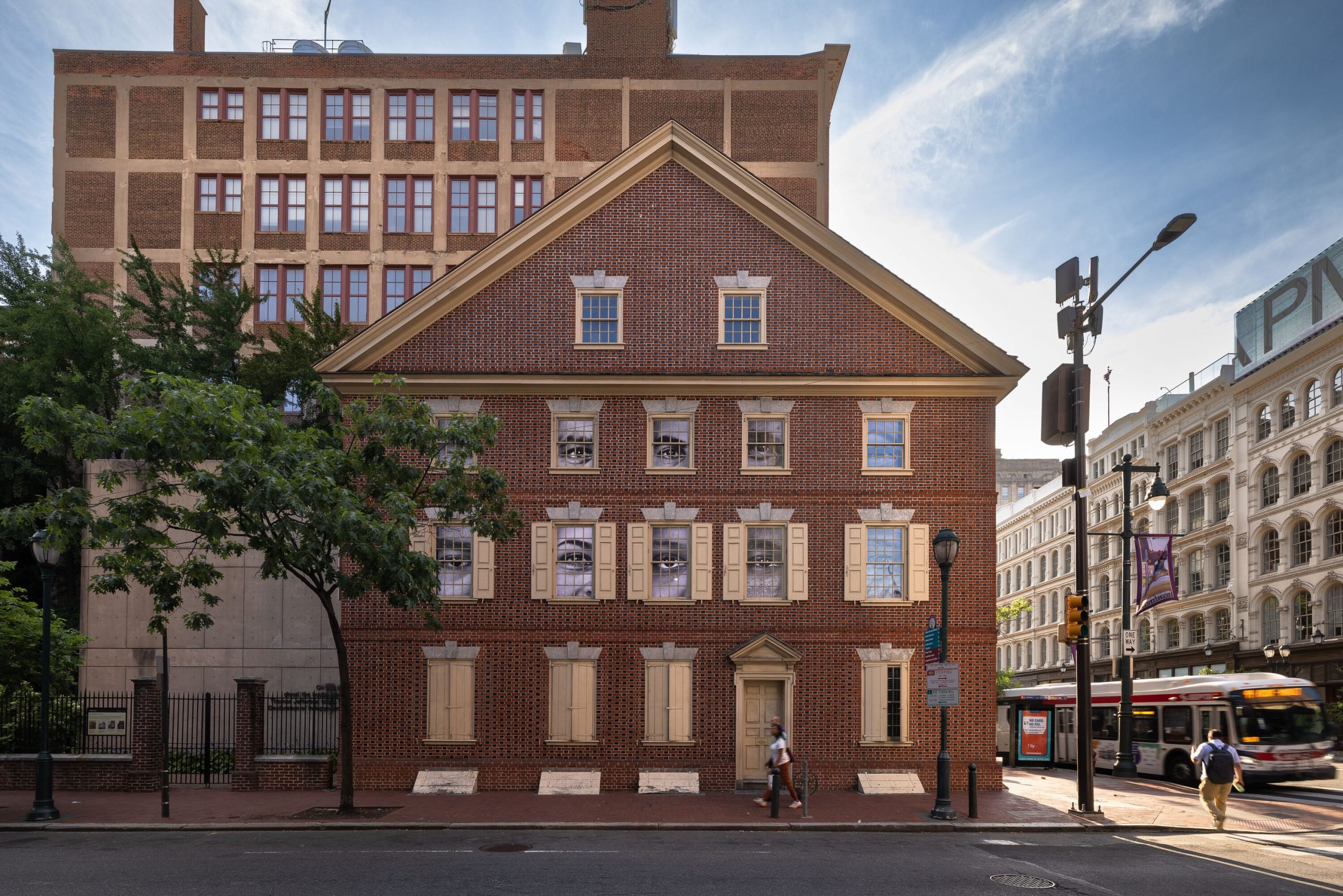
“If people say: ‘Whose eyes are those?’ I am good with that.”
Artist Sonya Clark was talking about her latest major project, a public artwork titled The Descendants of Monticello, that officially debuts today, June 24, at Declaration House, the Philadelphia landmark where Thomas Jefferson drafted the Declaration of Independence in 1776.
Clark, in partnership with nonprofit public art, history, and design studio Monument Lab, is shining a light on a lesser-known and discussed aspect of the historical narrative behind one of America’s founding documents. During that summer of 1776, Jefferson was accompanied by 14-year old Robert Hemmings, an enslaved valet that he brought with him from his plantation at Monticello, just outside Charlottesville, Virginia. Hemmings was also the half brother of Jefferson’s wife Martha Wayles Skelton.
Amid extensive research and a site visit to Monticello earlier this year, Clark realized that there are no known historical images of Hemmings. It became a driving force for the resulting art project: documenting the eyes of the descendants of the roughly 400 people enslaved at Monticello alone. The Descendants of Monticello encompasses a multichannel video installation facing the intersection of 7th and Market streets in Philadelphia.
Sonya Clark, The Descendants of Monticello (2024), on view at Declaration House, Independence National Historical Park, Philadelphia, PA. Photo: Steve Weinik/Monument Lab.
Contemporary video portraits of the eyes of living descendants are juxtaposed with photographs of those in Monticello’s archives. It is visible to anyone walking or driving past the site.
The videos “play in each window, blinking, watching, and haunting the space,” Clark told me. “But I also think of it as being a lighthouse in a way. I think of it as a reclamation.” Her last word nods to the title of the book of the same name, written by her friend Gayle Jessup White, who is herself a descendant of Jefferson.
From the very start of the project, Clark knew she would be working with the facade of Declaration House and that it would be a public-facing artwork. “I think of the windows as being like the soul of the building—what allows you to see in and see out—aligned with the idea of eyes being the window of our souls. The soul of the nation necessarily is these Black descendants and their eyes.”
The building itself, which is overseen by the National Park Service, is currently closed. The original was demolished in 1883, before it was reconstructed by the NPS in 1975.
Sonya Clark at Declaration House, Independence National Historical Park, Philadelphia, PA, 2024. Photo: Terrell Halsey/Monument Lab.
Clark said the windows are constantly in movement so viewers never see the same eye appear at the same time. “There is something really haunting about having a lot to singular eyes look at you. And you can tell there is so much information even in the reduction or cropping of the image.”
She worked directly with Jessup White, who also works at Monticello, and the Getting Word African American Oral History Project. Later the installation may travel to and be on display Monticello itself, where historians have recently uncovered new archival information about Hemmings such as samples of his handwriting.
In a previous project that was shown at the Fabric Workshop in 2019, titled Monumental Cloth, the Flag We Should Know, Clark delved into the history of a lesser-known flag in U.S. history, the one that was flown by the Confederacy during the Civil War and was used to surrender.
L to R: Paul Farber, director and co-founder of Monument Lab, author Gayle Jessup White, and artist Sonya Clark on a site visit to Monticello in connection with Getting Word, Declaration House, Charlottesville, VA, 2024. Photo: AJ Mitchell/Monument Lab.
The history of that flag of truce dates back to April 9, 1864, when Confederate General Robert E. Lee sent a rider forward waving it, putting an end to the long and deadly national conflict. Union General Ulysses S. Grant accepted the Confederacy’s surrender and cut the flag in half so that the rider, who had purchased the repurposed dishtowel just days before in Richmond, Virginia, could ensure safe passage back across Union lines. For that project, Clark teamed up with the Fabric Workshop to create 101 replicas of the cloth, including a massive one that was 100 times the size of the original.
As for Philadelphia and Declaration House, the official unveiling of the project today will be celebrated with a block party, as part of the city’s Welcome America festival, and 15,000 copies of a printed newspaper detailing the project and the significance of the Declaration of Independence will be distributed.
Sonya Clark, The Descendants of Monticello (2024), on view at Declaration House, Independence National Historical Park, Philadelphia, PA. Photo: Steve Weinik/Monument Lab.
Like most artists, Clark does not want to be prescriptive about what viewers take away but said it’s fine if people “walk away with an open-ended question.” She added: “That will allow the work to do what I believe artwork does very well. I love the capaciousness and generosity of artwork to hold as many thoughts and ideas as possible.”
The Descendants of Monticello is on view at Declaration House, 700 Market St, Philadelphia, through September 8.